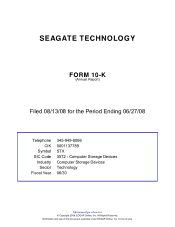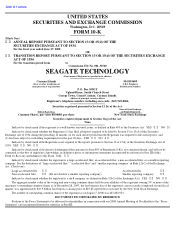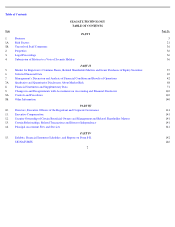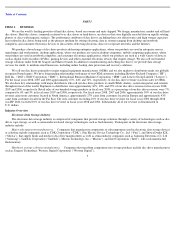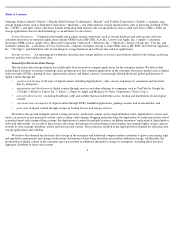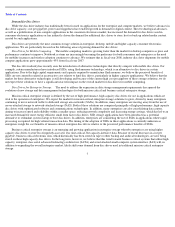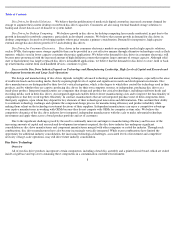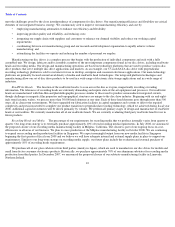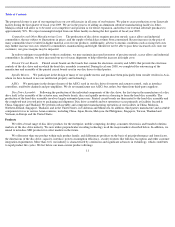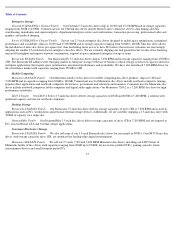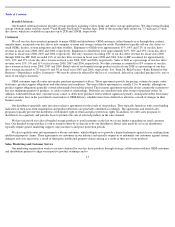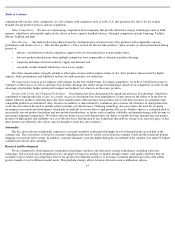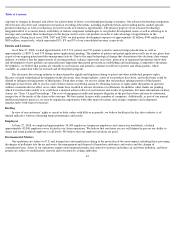Seagate 2007 Annual Report Download - page 7
Download and view the complete annual report
Please find page 7 of the 2007 Seagate annual report below. You can navigate through the pages in the report by either clicking on the pages listed below, or by using the keyword search tool below to find specific information within the annual report.
Table of Contents
Samsung, Fujitsu Limited (“Fujitsu”), Hitachi Global Storage Technologies (“Hitachi”) and Toshiba Corporation (“Toshiba”), magnetic tape
storage manufacturers such as Quantum Corporation (“Quantum”), and semiconductor storage manufacturers such as Samsung, SanDisk, STEC
Inc. (“STEC”), and Intel, whose operations include integrating flash memory into storage products such as solid state drives (SSDs). SSDs are
storage applications that use flash technology as an alternative to disc drives.
System integrators. Companies that bundle and package storage components such as storage hardware and software into end-user,
consumer electronics or enterprise applications include OEMs such as HP, Dell, Acer Inc., Lenovo and Apple, Inc. (“Apple”); consumer
electronics OEMs such as Apple, Sony, Microsoft Corporation (“Microsoft”), Motorola, Inc. (“Motorola”), Directv Group, Inc., Tivo Inc. and
Scientific-
Atlanta Inc., a subsidiary of Cisco Systems Inc. company; enterprise storage system OEMs such as HP, EMC and Network Appliance,
Inc. (“Net App”); and distributors who in turn integrate storage hardware and software into end user applications.
Storage services . An emerging area within the electronic data storage industry is services and solutions related to the backup, archiving,
recovery and discovery of electronic data.
Demand for Electronic Data Storage
The electronic data storage industry has traditionally been focused on compute applications for the enterprise market. We believe that
technological advances in storage technology and a proliferation of non-compute applications in the consumer electronics market such as digital
video recorders (DVRs), gaming devices, digital music players and digital cameras is increasingly driving the broad, global proliferation of
digital content through the:
•
creation and sharing of all types of digital content, including digital photos, video, movies and music by consumers and electronic
data by enterprises;
•
aggregation and distribution
of digital content through services and other offerings by companies such as YouTube by Google Inc.
(
“
Google
”
),
Flickr by Yahoo! Inc. (
“
Yahoo
”
),
iTunes by Apple and MySpace by News Corporation (
“
News Corp.
”
);
•
network infrastructure , including broadband, cable and satellite that has enabled the access, hosting and distribution of such digital
content;
•
enjoyment and consumption of digital content through DVRs, handheld applications, gaming consoles and in automobiles; and
We believe that growth in digital content is being driven by: media-rich content, such as high definition video, digital photos, movies and
music; an increase in user generated content, such as online video sharing, blogging and podcasting; the digitization of content previously stored
in analog format such as paper filing systems; the duplication of content in multiple locations, including consumers’
replication of digital photos,
video and other media. As a result of these factors, the nature and amount of content being created requires increasingly higher storage capacity
in order to store, manage, distribute, utilize and back up such content. This in turn has resulted in the rapid growth in demand for electronic data
storage applications and solutions.
We believe that demand for electronic data storage in the enterprise and traditional compute markets continues to grow as increasing legal
and regulatory requirements and changes in the nature and amount of data being stored has necessitated additional storage. Additionally, the
proliferation of digital content in the consumer space has resulted in additional demand for storage by enterprises, including those that host,
aggregate, distribute or share such content.
6
•
protection
of digital content through storage on backup devices and storage services.

